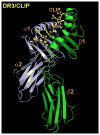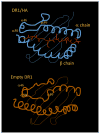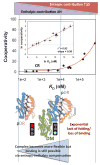For many but not for all: how the conformational flexibility of the peptide/MHCII complex shapes epitope selection
- PMID: 22753017
- PMCID: PMC4197051
- DOI: 10.1007/s12026-012-8342-2
For many but not for all: how the conformational flexibility of the peptide/MHCII complex shapes epitope selection
Abstract
The adaptive immune response starts when CD4+ T cells recognize peptide antigens presented by class II molecules of the Major Histocompatibility Complex (MHCII). Two outstanding features of MHCII molecules are their polymorphism and the ability of each allele to bind a large panoply of peptides. The ability of each MHCII molecule to interact with a limited, though broad, range of amino acid sequences, or "permissive specificity" of binding, is the result of structural flexibility. This flexibility has been identified through biochemical and biophysical studies, and molecular dynamic simulations have modeled the conformational rearrangements that the peptide and the MHCII undergo during interaction. Moreover, there is evidence that the structural flexibility of the peptide/MHCII complex correlates with the activity of the "peptide-editing" molecule DM. In light of the impact that these recent findings have on our ability to predict MHCII epitopes, a review of the structural and thermodynamic determinants of peptide binding to MHCII is proposed.
Figures




 . The impact of cooperative effects on peptide affinity has been investigated applying the mutant cycle approach to the DR/HA system. Due tothe disruptive nature of the modifications, the observed Cooperativity can be interpreted as lack of folding. Cooperativity affects complex formation in an exponential fashion, indicating that disrupting interaction after interaction has an amplified effect on the ability of the complex to fold into a stable conformer. At the left side of the curve, an affinity range can be identified, for which null or little cooperativity can be measured (Compensatory Range, CR framed in the plot). The broader is this range, the greater is the ability of the system to compensate any lack of interactions (H-bonds, Hydrophobic or salt bridges) with the residual flexibility (phenomenon of entropy-enthalpy compensation). To the extent that DM interacts and destabilizes complexes featuring greater residual entropy, thus reducing the compensatory range for stable complexion, this approach may also be used to identify the susceptibility to DM of a complex on the basis of its thermodynamic profile.
. The impact of cooperative effects on peptide affinity has been investigated applying the mutant cycle approach to the DR/HA system. Due tothe disruptive nature of the modifications, the observed Cooperativity can be interpreted as lack of folding. Cooperativity affects complex formation in an exponential fashion, indicating that disrupting interaction after interaction has an amplified effect on the ability of the complex to fold into a stable conformer. At the left side of the curve, an affinity range can be identified, for which null or little cooperativity can be measured (Compensatory Range, CR framed in the plot). The broader is this range, the greater is the ability of the system to compensate any lack of interactions (H-bonds, Hydrophobic or salt bridges) with the residual flexibility (phenomenon of entropy-enthalpy compensation). To the extent that DM interacts and destabilizes complexes featuring greater residual entropy, thus reducing the compensatory range for stable complexion, this approach may also be used to identify the susceptibility to DM of a complex on the basis of its thermodynamic profile.Similar articles
-
Predicting CD4 T-cell epitopes based on antigen cleavage, MHCII presentation, and TCR recognition.PLoS One. 2018 Nov 6;13(11):e0206654. doi: 10.1371/journal.pone.0206654. eCollection 2018. PLoS One. 2018. PMID: 30399156 Free PMC article.
-
Thermodynamics of Peptide-MHC Class II Interactions: Not all Complexes are Created Equal.Front Immunol. 2013 Oct 1;4:308. doi: 10.3389/fimmu.2013.00308. Front Immunol. 2013. PMID: 24101920 Free PMC article. Review.
-
Conformational variation in structures of classical and non-classical MHCII proteins and functional implications.Immunol Rev. 2012 Nov;250(1):144-57. doi: 10.1111/imr.12003. Immunol Rev. 2012. PMID: 23046127 Free PMC article. Review.
-
A single T cell receptor bound to major histocompatibility complex class I and class II glycoproteins reveals switchable TCR conformers.Immunity. 2011 Jul 22;35(1):23-33. doi: 10.1016/j.immuni.2011.04.017. Epub 2011 Jun 16. Immunity. 2011. PMID: 21683626 Free PMC article.
-
Peptide linkage to the α-subunit of MHCII creates a stably inverted antigen presentation complex.J Mol Biol. 2012 Oct 26;423(3):294-302. doi: 10.1016/j.jmb.2012.07.008. Epub 2012 Jul 20. J Mol Biol. 2012. PMID: 22820093
Cited by
-
MHC class II complexes sample intermediate states along the peptide exchange pathway.Nat Commun. 2016 Nov 9;7:13224. doi: 10.1038/ncomms13224. Nat Commun. 2016. PMID: 27827392 Free PMC article.
-
A Newly Recognized Pairing Mechanism of the α- and β-Chains of the Chicken Peptide-MHC Class II Complex.J Immunol. 2020 Mar 15;204(6):1630-1640. doi: 10.4049/jimmunol.1901305. Epub 2020 Feb 7. J Immunol. 2020. PMID: 32034060 Free PMC article.
-
Side-Chain Conformational Preferences Govern Protein-Protein Interactions.J Am Chem Soc. 2016 Aug 24;138(33):10386-9. doi: 10.1021/jacs.6b04892. Epub 2016 Aug 9. J Am Chem Soc. 2016. PMID: 27483190 Free PMC article.
-
Characterization of T Cells Specific for CFP-10 and ESAT-6 in Mycobacterium tuberculosis-Infected Mauritian Cynomolgus Macaques.Infect Immun. 2017 Mar 23;85(4):e01009-16. doi: 10.1128/IAI.01009-16. Print 2017 Apr. Infect Immun. 2017. PMID: 28115506 Free PMC article.
-
A Simplified Amino Acidic Alphabet to Unveil the T-Cells Receptors Antigens: A Computational Perspective.Front Chem. 2021 Feb 25;9:598802. doi: 10.3389/fchem.2021.598802. eCollection 2021. Front Chem. 2021. PMID: 33718327 Free PMC article.
References
-
- Benacerraf B. Role of MHC gene products in immune regulation. Science. 1981;212(4500):1229–38. Epub 1981/06/12. - PubMed
-
- Nelson CA, Fremont DH. Structural principles of MHC class II antigen presentation. Rev Immunogenet. 1999;1(1):47–59. - PubMed
-
- Chaturvedi P, Yu Q, Southwood S, Sette A, Singh B. Peptide analogs with different affinites for MHC alter the cytokine profile of T helper cells. Int Immunol. 1996;8(5):745–55. - PubMed
-
- Engelhard VH. Structure of peptides associated with class I and class II MHC molecules. Annu Rev Immunol. 1994;12:181–207. - PubMed
-
- Lippolis JD, White FM, Marto JA, Luckey CJ, Bullock TN, Shabanowitz J, et al. Analysis of MHC class II antigen processing by quantitation of peptides that constitute nested sets. J Immunol. 2002;169(9):5089–97. - PubMed
Publication types
MeSH terms
Substances
Grants and funding
LinkOut - more resources
Full Text Sources
Research Materials

